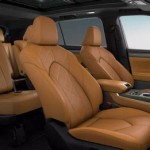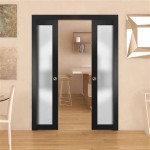Exploring The Interior Of A Third Row Toyota 4Runner
The Toyota 4Runner, a rugged and reliable sport utility vehicle, has maintained its popularity for decades. While known for its off-road capabilities and durable construction, the interior of the 4Runner, particularly in models equipped with a third row, also deserves careful consideration. This article delves into the interior features and functionality of a third-row Toyota 4Runner, examining its practicality, comfort, and overall space utilization.
The availability of a third row in the 4Runner significantly expands its passenger-carrying capacity. This option transforms the vehicle from a five-seater to a seven-seater, making it a viable choice for larger families or those who frequently transport multiple passengers. However, this added capacity comes with trade-offs in terms of cargo space and overall comfort, particularly for those relegated to the rearmost seats.
The interior design of the 4Runner adheres to Toyota's pragmatic approach, prioritizing functionality and durability over opulent luxury. The materials used are generally robust and easy to clean, which is beneficial for a vehicle often subjected to outdoor adventures and family use. The dashboard layout is straightforward, with clearly labeled controls and a user-friendly infotainment system. While some may find the interior design somewhat dated compared to newer SUVs, its simplicity contributes to its ease of operation.
Third Row Seating: Dimensions and Access
The third-row seating in the 4Runner is primarily designed for children or smaller adults. The legroom is limited, and the seat cushions are relatively low, making it less comfortable for taller individuals on longer journeys. The dimensions of the third row vary slightly depending on the specific model year and trim level, but generally, the legroom measures around 29.3 inches. This is considerably less than the legroom offered in the second row, which typically measures around 32.9 inches.
Gaining access to the third row involves folding and sliding the second-row seats forward. This can be accomplished relatively easily, although it may require some effort, especially for younger or less physically able passengers. The opening created for entry and exit is adequate, but not exceptionally wide, meaning that passengers may need to maneuver themselves carefully to avoid bumping their heads or knees. Some 4Runners are equipped with a one-touch fold-and-slide mechanism, which simplifies the process of accessing the third row.
Once seated in the third row, headroom can be a constraint, particularly for taller individuals. The sloping roofline of the 4Runner reduces the available headroom in the rear, which can make it feel cramped. The seat height is also lower than the other rows, resulting in a knees-up seating position that may become uncomfortable on extended trips.
It's important to note that the third row seats are not designed for frequent use by adults. They are best suited for occasional transport of children or short trips within the city. For families who regularly need to transport more than five adults, a larger SUV with more spacious third-row seating, such as the Toyota Sequoia or the Chevrolet Tahoe, would be a more suitable option.
Cargo Capacity with Third Row Up and Down
With the third row in use, the cargo space in the 4Runner is significantly reduced. The available space behind the third row measures approximately 9 cubic feet. This is generally sufficient for a few grocery bags or small backpacks, but not enough for larger items such as suitcases or camping gear. Families planning to travel with a full complement of passengers and luggage will likely need to utilize a roof rack or a cargo carrier to accommodate their belongings.
When the third-row seats are folded down, the cargo space expands considerably, providing a more practical storage area. With the third row folded, the cargo capacity increases to approximately 47.2 cubic feet. This allows for the transport of larger items such as strollers, sports equipment, or multiple suitcases. The folding mechanism for the third row is generally straightforward, allowing for easy reconfiguration of the interior space.
With both the second and third rows folded down, the 4Runner offers a maximum cargo capacity of approximately 89.7 cubic feet. This provides a substantial amount of space for hauling large items or transporting bulky equipment. The flat load floor created when the seats are folded down makes it easier to load and unload cargo, and also provides a comfortable surface for sleeping if necessary.
The cargo area of the 4Runner includes several useful features, such as tie-down points and storage compartments, which help to secure and organize cargo. Some models also feature a sliding rear cargo deck, which makes it easier to load and unload heavy items. The rear liftgate can be operated manually or, in some trim levels, with a power-operated mechanism.
Ultimately, the cargo capacity of the third-row 4Runner is a compromise. While the third row provides additional passenger-carrying capability, it significantly reduces the available cargo space when in use. Prospective buyers should carefully consider their typical usage patterns and determine whether the added passenger capacity outweighs the reduction in cargo space.
Comfort and Features in the Front and Second Rows
While the third row is primarily focused on, the comfort and features of the front and second rows also contribute significantly to the overall passenger experience in the 4Runner. The front seats are generally comfortable and supportive, providing adequate cushioning for long drives. Many models feature power-adjustable seats with lumbar support, allowing drivers and front passengers to customize their seating position for optimal comfort.
The second-row seats offer ample legroom and headroom for adults, making them a comfortable place to sit on longer journeys. The seats can be reclined to enhance passenger comfort, and some models feature a center armrest with cupholders. The second row also benefits from dedicated air vents, allowing passengers to control the temperature in their seating area.
The infotainment system in the 4Runner is generally user-friendly and integrates well with the overall interior design. The system typically includes a touchscreen display, which allows for easy access to navigation, audio, and vehicle settings. Compatibility with Apple CarPlay and Android Auto is also common, allowing drivers to seamlessly integrate their smartphones with the vehicle's infotainment system.
The 4Runner offers a range of convenience features, such as automatic climate control, power windows and locks, and keyless entry. Higher trim levels may include additional features such as leather upholstery, heated seats, and a sunroof. These features enhance the overall comfort and convenience of the vehicle, making it a more enjoyable place to spend time.
Noise levels inside the 4Runner can be somewhat higher than in some other SUVs, particularly at highway speeds. The vehicle's boxy shape and rugged construction contribute to wind noise, and the engine can also be audible under acceleration. However, the noise levels are generally tolerable and do not significantly detract from the overall driving experience.
The quality of the interior materials in the 4Runner is generally good, although some may find the abundance of hard plastics to be less appealing than the soft-touch materials found in some other SUVs. However, the materials are durable and easy to clean, which is an important consideration for a vehicle that is likely to be subjected to heavy use. The overall fit and finish of the interior is generally solid, reflecting Toyota's commitment to quality and reliability.
In conclusion, the interior of a third-row Toyota 4Runner offers a blend of practicality, durability, and functionality. While the third-row seating is best suited for children or smaller adults, it expands the vehicle's passenger-carrying capacity, making it a viable option for larger families. The cargo space is reduced when the third row is in use, but it expands significantly when the seats are folded down. The front and second rows offer ample comfort and a range of features that enhance the overall passenger experience.

Toyota 4runner Interior Review Houston Tx Mike Calvert

Explore The 2024 Toyota 4runner Interior With Jim Hudson

2024 Toyota 4runner Interior Features Dimensions Savannah

Does The Toyota 4runner Have Third Row Seating O Brien

2024 Toyota 4runner Interior Seating Size

2024 Toyota 4runner Interior Galaxy Eatontown

2024 Toyota 4runner Interior Woburn

Which Toyota Suv Has Third Row Seating Milton Martin

2024 4runner Offers Third Row Very Cool Sr5 And Limited Styles Toyota Interior Tacoma

2024 Toyota 4runner Limited 4dr 4x2 Suv Trim Details Reviews S Specs Photos And Incentives Autoblog
Related Posts








